In Semiotics in Ethics and Caring, Susan Petrilli affirms that an ethical dimension is implicit in every form of human semiosis. Yet only recently has it become a consistent object of semiotic inquiry. Drawing on Thomas A. Sebeok’s notion of global semiotics, she argues that reconnecting semiotics with the life sciences allows the discipline to extend beyond epistemology narrowly conceived as gnoseology, and thus to open itself toward ethics.
This orientation finds expression in the term “semioethics,” first introduced in the early 1980s and developed in collaboration with Augusto Ponzio. Petrilli explains that this neologism was chosen over others—such as tel(e)osemiotics, ethosemiotics, or ethical semiotics—to designate research into the ethical dimension of semiosis within the framework of a semiotics of life. Semioethics, she notes, investigates “the ethical dimension of semiosis” as an intrinsic component of sign activity, not as an external moral supplement.
From Symptomatology to Global Semiotics
Petrilli traces the beginnings of semiotics back to ancient symptomatology, the medical tradition inaugurated by Hippocrates and later developed by Galen. In the Hippocratic oath, ethics is not limited to professional conduct but concerns the individual’s relation to life itself: the physician, Hippocrates wrote, must aid both citizens and foreigners alike, even without payment, for “where there is love for art, there is love for humanity.” Galen too maintained that science and ethics cannot be separated.
By revisiting these roots, Petrilli suggests, semiotics rediscovers its original vocation as care for life. To identify these “cryptosemioticians,” those who practised the interpretation of signs before the word semiotics was coined, is not merely to trace historical origins but to reconnect semiotics with its fundamental object: the living process of interpretation and response.
Semiotics and Semeiotics
Reconnecting semiotics with semeiotics—that is, the study of symptoms—reshapes the orientation of semiotic research. Whether its genealogy begins with Hippocrates, Locke, Saussure, or Uexküll determines what counts as central or peripheral to its models of signification. When semiotics acknowledges its descent from medical semeiotics, it extends its field from human sciences to the biological and clinical sciences, widening its horizon to encompass the totality of life processes.
This historical-theoretical reconnection underpins what Petrilli and Ponzio call semioethics: an interdisciplinary approach that insists on the interdependence of all sciences. Against the fragmentation produced by specialization, semioethics restores the sense of interconnectivity among natural, mathematical, and human sciences—the diverse spheres of semiosis that they each explore.
Caring for the Signs of Life
In Sebeok’s terms, semiotics becomes “global semiotics” when it distinguishes between semiosis (sign activity) and semiotic (reflection upon signs). Reunited with semeiotics, semiotics refines its ability to interpret the symptoms of social illness—alienation in its social, linguistic, economic, political, and ecological forms. Because semiosis and life coincide, the study of signs necessarily concerns the health of life on the planet.
From this standpoint, Petrilli warns that to describe signs merely in terms of their function or efficiency, as if human semiosis were neutral, is inadequate. Social practice, she insists, is never neutral: it is oriented by planning, ideology, and value. To neglect critique is to become indifferent to the other—and indifference, she adds, “can only lead to global disaster,” as witnessed by contemporary ecological and humanitarian crises.
The Semioethical Vocation
For Petrilli, the ultimate task of semiotics is not only theoretical but ethical-pragmatic. To care for the signs of life means to assume responsibility for the conditions of communication that sustain the biosphere. This commitment entails surpassing the limits of theoreticism and engaging in practical reason: the health of life becomes both the object and the goal of semiotic inquiry.
In this sense, semioethics is not a branch of semiotics, nor a new discipline; it is the rediscovery of semiotics’ original vocation as semeiotics for life. To study signs is to engage with symptoms—physical, social, and linguistic—and thus to care for the living world that these signs manifest. The health of semiosis and the health of life, Petrilli concludes, are one and the same.
Riferimento bibliografico: Susan Petrilli, Semiotics in Ethics and Caring, in Bloomsbury Semiotics. Semiotics in the Arts and Social Sciences, Vol. 3, Bloomsbury, 2023.
